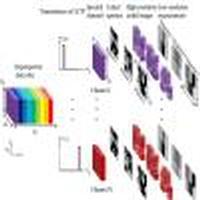当前位置:
X-MOL 学术
›
Photonics Res.
›
论文详情
Our official English website, www.x-mol.net, welcomes your
feedback! (Note: you will need to create a separate account there.)
Super-resolution compressive spectral imaging via two-tone adaptive coding
Photonics Research ( IF 6.6 ) Pub Date : 2020-02-28 , DOI: 10.1364/prj.377665 Chang Xu , Tingfa Xu , Ge Yan , Xu Ma , Yuhan Zhang , Xi Wang , Feng Zhao , Gonzalo R. Arce
Photonics Research ( IF 6.6 ) Pub Date : 2020-02-28 , DOI: 10.1364/prj.377665 Chang Xu , Tingfa Xu , Ge Yan , Xu Ma , Yuhan Zhang , Xi Wang , Feng Zhao , Gonzalo R. Arce

|
Coded apertures with random patterns are extensively used in compressive spectral imagers to sample the incident scene in the image plane. Random samplings, however, are inadequate to capture the structural characteristics of the underlying signal due to the sparsity and structure nature of sensing matrices in spectral imagers. This paper proposes a new approach for super-resolution compressive spectral imaging via adaptive coding. In this method, coded apertures are optimally designed based on a two-tone adaptive compressive sensing (CS) framework to improve the reconstruction resolution and accuracy of the hyperspectral imager. A liquid crystal tunable filter (LCTF) is used to scan the incident scene in the spectral domain to successively select different spectral channels. The output of the LCTF is modulated by the adaptive coded aperture patterns and then projected onto a low-resolution detector array. The coded aperture patterns are implemented by a digital micromirror device (DMD) with higher resolution than that of the detector. Due to the strong correlation across the spectra, the recovered images from previous spectral channels can be used as a priori information to design the adaptive coded apertures for sensing subsequent spectral channels. In particular, the coded apertures are constructed from the a priori spectral images via a two-tone hard thresholding operation that respectively extracts the structural characteristics of bright and dark regions in the underlying scenes. Super-resolution image reconstruction within a spectral channel can be recovered from a few snapshots of low-resolution measurements. Since no additional side information of the spectral scene is needed, the proposed method does not increase the system complexity. Based on the mutual-coherence criterion, the proposed adaptive CS framework is proved theoretically to promote the sensing efficiency of the spectral images. Simulations and experiments are provided to demonstrate and assess the proposed adaptive coding method. Finally, the underlying concepts are extended to a multi-channel method to compress the hyperspectral data cube in the spatial and spectral domains simultaneously.
中文翻译:

基于双色调自适应编码的超分辨率压缩光谱成像
具有随机图案的编码孔径广泛用于压缩光谱成像仪,以对图像平面中的入射场景进行采样。然而,由于光谱成像器中传感矩阵的稀疏性和结构特性,随机采样不足以捕捉潜在信号的结构特征。本文提出了一种通过自适应编码进行超分辨率压缩光谱成像的新方法。在该方法中,基于双色调自适应压缩感知 (CS) 框架优化设计编码孔径,以提高高光谱成像仪的重建分辨率和精度。液晶可调滤光片(LCTF)用于在光谱域中扫描入射场景以依次选择不同的光谱通道。LCTF 的输出由自适应编码孔径图案调制,然后投影到低分辨率探测器阵列上。编码孔径图案由分辨率高于探测器分辨率的数字微镜器件 (DMD) 实现。由于光谱之间的强相关性,从先前光谱通道恢复的图像可以用作先验信息来设计自适应编码孔径以感知后续光谱通道。特别地,编码孔径是通过双色调硬阈值操作从先验光谱图像构建的,该操作分别提取底层场景中亮区和暗区的结构特征。光谱通道内的超分辨率图像重建可以从低分辨率测量的几个快照中恢复。由于不需要光谱场景的附加边信息,所提出的方法不会增加系统复杂度。基于相互相干准则,所提出的自适应 CS 框架在理论上被证明可以提高光谱图像的感知效率。提供了模拟和实验来演示和评估所提出的自适应编码方法。最后,将基本概念扩展到多通道方法,以同时压缩空间域和光谱域中的高光谱数据立方体。提供了模拟和实验来演示和评估所提出的自适应编码方法。最后,将基本概念扩展到多通道方法,以同时压缩空间域和光谱域中的高光谱数据立方体。提供了模拟和实验来演示和评估所提出的自适应编码方法。最后,将基本概念扩展到多通道方法,以同时压缩空间域和光谱域中的高光谱数据立方体。
更新日期:2020-02-28
中文翻译:

基于双色调自适应编码的超分辨率压缩光谱成像
具有随机图案的编码孔径广泛用于压缩光谱成像仪,以对图像平面中的入射场景进行采样。然而,由于光谱成像器中传感矩阵的稀疏性和结构特性,随机采样不足以捕捉潜在信号的结构特征。本文提出了一种通过自适应编码进行超分辨率压缩光谱成像的新方法。在该方法中,基于双色调自适应压缩感知 (CS) 框架优化设计编码孔径,以提高高光谱成像仪的重建分辨率和精度。液晶可调滤光片(LCTF)用于在光谱域中扫描入射场景以依次选择不同的光谱通道。LCTF 的输出由自适应编码孔径图案调制,然后投影到低分辨率探测器阵列上。编码孔径图案由分辨率高于探测器分辨率的数字微镜器件 (DMD) 实现。由于光谱之间的强相关性,从先前光谱通道恢复的图像可以用作先验信息来设计自适应编码孔径以感知后续光谱通道。特别地,编码孔径是通过双色调硬阈值操作从先验光谱图像构建的,该操作分别提取底层场景中亮区和暗区的结构特征。光谱通道内的超分辨率图像重建可以从低分辨率测量的几个快照中恢复。由于不需要光谱场景的附加边信息,所提出的方法不会增加系统复杂度。基于相互相干准则,所提出的自适应 CS 框架在理论上被证明可以提高光谱图像的感知效率。提供了模拟和实验来演示和评估所提出的自适应编码方法。最后,将基本概念扩展到多通道方法,以同时压缩空间域和光谱域中的高光谱数据立方体。提供了模拟和实验来演示和评估所提出的自适应编码方法。最后,将基本概念扩展到多通道方法,以同时压缩空间域和光谱域中的高光谱数据立方体。提供了模拟和实验来演示和评估所提出的自适应编码方法。最后,将基本概念扩展到多通道方法,以同时压缩空间域和光谱域中的高光谱数据立方体。











































 京公网安备 11010802027423号
京公网安备 11010802027423号